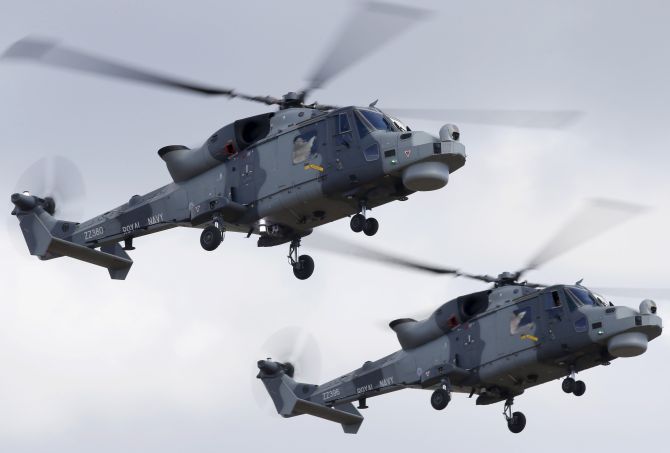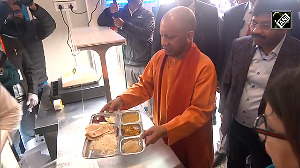A Rs 36 billion deal for helicopters to ferry VVIPs that ran into rough weather ...
A controversy that now threatens to park itself at the doorsteps of the Congress party...
Nitin Gokhale, national security expert and founder BharatShakti.in, tells us what the controversy is all about.

What was the need to buy new VVIP helicopters and when did the process begin?
2000: Aware that the Mi-8 VVIP helicopter fleet had only 10 years to go before being phased out, the Indian Air Force suggested to the Prime Minister’s Office and to the defence ministry that there was a need to look for suitable and modern replacement.
The MI-8 helicopters are a typical Russian product -- sturdy, dependable, but with very little comfort level to offer.
Air Chief Marshal A Y Tipnis was the then chief of the air staff. A Request For the Proposal, RFP, was floated. Six companies responded.
One of the key requirements in that RFP was that the competing helicopters must be able to fly at altitudes around 6,000 metres with a full load.
After trials, only one helicopter -- the Eurocopter’s EC 225 -- was able to fly at that altitude.
In 2003, the IAF sent its evaluation report to the PMO. Brajesh Mishra, then national security adviser and principal secretary to then prime minister Atal Bihari Vajpayee, asked the Special Protection Group that guards India’s VVIPs, for its comments.
The SPG apparently said the EC-225 was unsuitable because its cabin height was too short (at 1.39 metres) and that neither the VIPs nor the SPG personnel would be able to stand upright inside such a cabin.
Mishra then wrote to Air Chief Marshal S Krishnaswamy who had taken over from ACM Tipnis in 2001, expressing concern on two points: A single vendor situation had arisen because of the specification that said the helicopters must be able to fly at altitudes around 6,000 metres and that the SPG’s inputs were not taken.
Having seen that letter briefly, I remember a couple of lines from it. It said, in part: ‘It is unfortunate that SPG wasn’t taken on board... I suggest you and the defence secretary work out the specifications in consultation with the SPG..’
Mishra’s point was that the competition must be broadened and the SPG’s requirements must be met.
So, the IAF, in consultation with the SPG, drew up the entire Air Staff Qualitative Requirement once again. That was in 2003.
The new specifications said the helicopters must be able to fly at an altitude of 4,500 metres and that its cabin must be at least 1.80 m in height.
Meanwhile, Air Marshal S P Tyagi took over as IAF chief in 2004. It took Air Headquarters and the defence ministry’s acquisition wing another three years to issue a fresh Request For the Proposal. That was in 2006.
By then Vajpayee’s National Democratic Alliance government had been ousted, and the United Progressive Alliance was in power.
The new RFP, which went by the specifications finalised in 2003, was issued to six different vendors when Pranab Mukherjee, now India’s President, was the defence minister.
Three companies -- the makers of Mi-172, Sikorsky which made the S-92 helicopters and AgustaWestland’s AWA101 -- responded to the RFP.
Meanwhile, the defence ministry put in place a new concept -- the Defence Procurement Procedure.
Under this, all companies that bid for contracts above Rs 1 billion have to sign an integrity pact that binds the companies to give an undertaking that no bribes would be paid or that agents would be used in the contracts.
The Russian company that manufacturers the Mi-172 withdrew from the competition at an early stage refusing to sign the integrity contract!
That left AgustaWestland and Sikorsky in the race. By now this was late 2007.
Fali H Major, himself a helicopter pilot, had meanwhile taken over as the IAF chief.
The evaluations and trials of the S-92 and AW101 began and continued over the next couple of years (2008-2009).
According to IAF sources, the S-92 was found to be non-compliant on four counts:
1. It could not reach 15,000 feet without maximum power.
2. Its 'hover out off ground effect' was insufficient.
3. Its drift down altitude did not meet the requirement.
4. Its missile airborne warning system was not up to the mark.
AgustaWestland, with its three engines, was a bonus, according to IAF test pilots since one engine failure still meant it had two engines to fall back upon.
Sometime in 2009, Air HQ sent its recommendation to the defence ministry and after going through stringent financial and technical requirements mandatory under the DPP, a contract was signed in February 2010.
By this time, Air Chief Marshal P V Naik was the air chief.
The first of the AW 101 AgustaWestland helicopters arrived in India in late 2012. Two more helicopters followed in quick succession.
When a controversy over the deal emerged in 2013 with the arrest of Agusta's parent organisation Finmeccanica CEO Giuseppe Orsi by Italian authorities, the then United Progressive Alliance government cancelled the deal, recovered the advance paid to the chopper manufacturer and instituted a probe against the alleged middlemen and beneficiaries
So were there middlemen? Who were they and why were they present in getting the deal in spite of India disallowing them to function here?
Allegedly, Guido Ralph Haschke, his partner Carlos Gerosa and London-based consultant Christian Michel were paid kickbacks totalling € (around Rs 4 billion) in the Rs 36 billion deal for 12 VVIP helicopters inked with AgustaWestland, the UK-based subsidiary of Italian conglomerate Finmeccanica, in February 2010.
The Central Bureau of Investigation’s First Information Report says: ‘Guido Haschke and Carlo Gerosa managed to send €5.6 million (over Rs 470 million) through the Mohali-based IDS Infotech and Chandigarh-based Aeromatrix Info Solutions Private Limited to India and kept the remaining amount of about €24.30 million (around Rs 2.05 billion) received from AgustaWestland with themselves in the account of IDS Tunisia.’
Haschke had earlier claimed that €6 million (over Rs 510 million) were paid to IAF officers and €8.4 million (around Rs 710 million) to bureaucrats, with politicians also getting a cut in the AgustaWestland deal.
Prosecutors have claimed that money was paid to close associates of former Indian Air Force chief SP Tyagi, who is named as a prime accused in the Italian prosecution case. Italian prosecutors have also alleged that another part of the bribe money was paid through UK-based consultant Christian Michel to political entities in India, and speculated that senior leaders of the then ruling party, Congress, were among the recipients.
Was Congress president Sonia Gandhi named in the court hearing in Italy? Why?
Prosecutors in an Italian court produced a note purportedly written by Christian Michel revealing that he had advised the people handling the VVIP helicopter deal on the company’s behalf to target people close to Congress president Sonia Gandhi, including the prime minister and some of her closest advisers, to win the contract.
The note written in March 2008 by middleman Christian Michel to Peter Hullet, India head of the Anglo-Italian company, was produced by the prosecutors in an Italian court where a trial is underway in the bribe scam.
In the note, Michel reportedly termed Sonia as the driving force behind the deal and advised Hullet to 'target' people close to her to clinch the deal.
"Dear Peter, since Sonia Gandhi is the driving force behind VIP will no longer fly in the MI-8. Gandhi and her closest advisers are the people who the British ambassador should target," said the letter of Michel seized by the probe team. This letter was seized from the home of arrested middlemen Guido Haschke in early 2013.
What does the April 16 verdict of the Italian appeals court say about involvement of Indian politicians in the payoffs?
Michel's note reportedly mentions among others, Sonia’s political secretary Ahmed Patel, Pranab Mukherjee, M Veerappa Moily, then national security adviser M K Narayanan and Vinay Kumar, a defence ministry official in charge of IAF procurement.
The 225-page judgment of the appeal court in Milan says Haschke identified all the Congress leaders, when their photos were shown to him during the trial by the Italian prosecution.
Page No 163 and 164 name Manmohan Singh and details that Orsi used Italian leadership and diplomats to contact the then prime minister to scuttle the probe by non-cooperation from the Indian Government's side.
In Page 163, the judgment produces a handwritten note by Orsi from jail in July 2013 asking his people to contact then Italian Prime Minister Monti or Ambassador Teracciano to call Dr Singh.
"Call Monti or amb. Teracciano in my name to ask him to call the PM Singh," said the note seized from the prison cell of Orsi. The judgment in several areas blames the non-cooperation from Indian authorities including the Defence Ministry and other probe agencies in 2013, when the Congress-led UPA was in power.
What does the judgment say about former air chief Tyagi's role?
The judgement has a separate 17-page chapter on SP Tyagi explaining the grounds on which it came to the conclusion on the corruption of the former IAF chief.
Tyagi is alleged to have intervened in favour of AgustaWestland for the VVIP helicopters competition.
The Italian court order said that payments to Tyagi and his family -- including three of his cousins, were made in cash and through wire transfers.
This report is an updated version of an earlier FAQ on the controversial deal posted in February 2014














 © 2025
© 2025